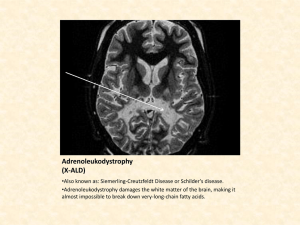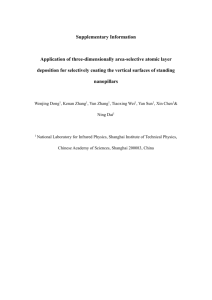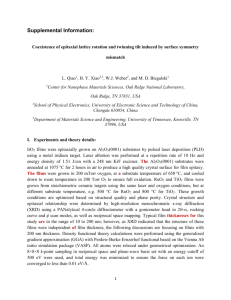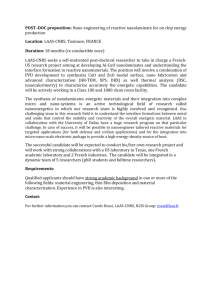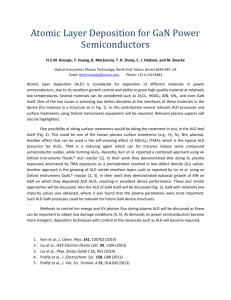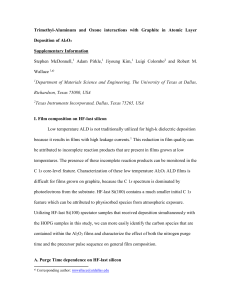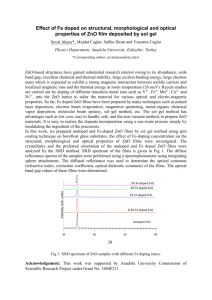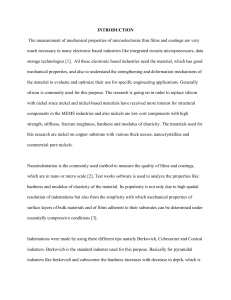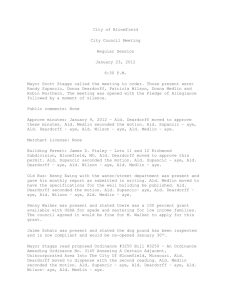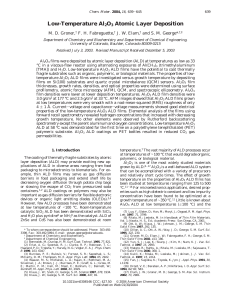Supplementary_Information_d
advertisement
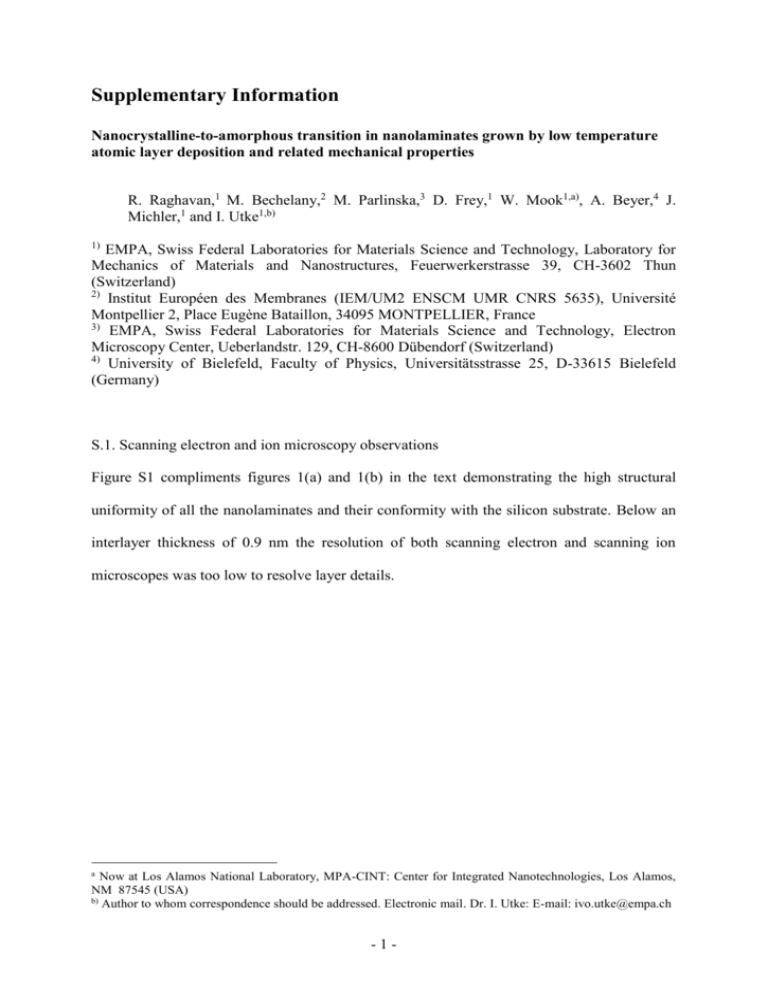
Supplementary Information Nanocrystalline-to-amorphous transition in nanolaminates grown by low temperature atomic layer deposition and related mechanical properties R. Raghavan,1 M. Bechelany,2 M. Parlinska,3 D. Frey,1 W. Mook1,a), A. Beyer,4 J. Michler,1 and I. Utke1,b) 1) EMPA, Swiss Federal Laboratories for Materials Science and Technology, Laboratory for Mechanics of Materials and Nanostructures, Feuerwerkerstrasse 39, CH-3602 Thun (Switzerland) 2) Institut Européen des Membranes (IEM/UM2 ENSCM UMR CNRS 5635), Université Montpellier 2, Place Eugène Bataillon, 34095 MONTPELLIER, France 3) EMPA, Swiss Federal Laboratories for Materials Science and Technology, Electron Microscopy Center, Ueberlandstr. 129, CH-8600 Dübendorf (Switzerland) 4) University of Bielefeld, Faculty of Physics, Universitätsstrasse 25, D-33615 Bielefeld (Germany) S.1. Scanning electron and ion microscopy observations Figure S1 compliments figures 1(a) and 1(b) in the text demonstrating the high structural uniformity of all the nanolaminates and their conformity with the silicon substrate. Below an interlayer thickness of 0.9 nm the resolution of both scanning electron and scanning ion microscopes was too low to resolve layer details. a Now at Los Alamos National Laboratory, MPA-CINT: Center for Integrated Nanotechnologies, Los Alamos, NM 87545 (USA) b) Author to whom correspondence should be addressed. Electronic mail. Dr. I. Utke: E-mail: ivo.utke@empa.ch -1- FIG S1. a) High-resolution scanning electron / ion microscope images of cross-sections of the nanolaminates obtained by breaking the substrate. Thicknesses of Al2O3 and ZnO layers are indicated. A high uniformity of the nanolaminate structure across the entire film thickness was observed. S.2. Indentation experiments Figure S2 shows the load-displacement curves obtained from the nanolaminates and films of their constituent compounds ZnO and Al2O3. It is clearly evident that the nanolaminates with smaller bilayer thickness not only exhibit higher penetration depths at the same load, but also more creep (shown as h values in the graphs) during the hold at the maximum load of 1 mN. This proves that the smaller the interlayer spacing, the softer is the nanolaminate. -2- FIG S2. Load-displacement curves obtained from nanoindentation of the low-temperature ALD films of Al2O3 and ZnO, and nanolaminates with bilayer thickness using a Berkovich indenter. For sake of clarity, the load-displacement curves are split into (a) the loading segment and (b) the unloading segment. The creep value, h, while keeping the maximum load of 1 mN constant for 10s is indicated for each nanolaminate bilayer thickness. The inset illustrates the full indentation cycle. S.3. Experimental Section A. Synthesis: A custom made ALD chamber was used for synthesizing the thin TCO films.1 Single-crystal wafers of (111) Si were pre-cleaned in acetone for 5 min and 1 wt % HF for 5 min to remove both organic contaminants and the native oxide. Next, the specimens were immersed in H2O2/H2SO4 solution for 15 min to produce a hydrophilic surface formed by the terminal silanol (SiOH) groups. After this pre-treatment, the sample was loaded in the ALD reactor. The ZnO ALD films were deposited using alternating exposures of diethylzinc (Zn(CH2CH3)2, 95% purity, CAS: 557-20-0, Strem Chemicals) and deionized H2O. The selflimiting ALD surface reactions leading to ZnO were proposed to be:2 ZnOH* + Zn(CH2CH3)2 ZnOZn(CH2CH3)* + CH3CH3 -3- (3) Zn(CH2CH3)* + H2O ZnOH* + CH3CH3 (4) where the asterisks represent the surface species. The Al2O3 ALD films were deposited using alternating trimethylaluminium (Al(CH3)3, 97% purity, CAS:75-24-1, Aldrich) and deionized H2O exposures. The following self-limiting ALD surface reactions leading to Al2O3 were proposed to be: 3 AlOH* + Al(CH3)3 AlOAl(CH3)2* + CH4 (5) AlCH3* + H2O AlOH* + CH4 (6) where the asterisks represent the surface species. ALD was carried out at 65°C with the following cycle times: 0.1 s pulse (diethylzinc or trimethyaluminium), 20 s exposure, and 45 s purge with dry argon. A 1 s pulse, 20 s exposure and 60 s purge with dry argon was used for H2O. These pulses, exposure and purge times were chosen conservatively to ensure completion of the ALD surface reactions and to prevent inadvertent mixing of the reactive gases. The nanolaminates were synthesized by alternating ALD cycles of ZnO and Al2O3, for details see Table 1. B. Structural characterization: The thicknesses of films, interlayers, and bilayers of the nanolaminates were characterized using a Hitachi S-4800 high resolution scanning electron microscope (HRSEM) and a ZEISS ORION® PLUS scanning helium focused ion beam microscope. Rutherford Backscattering Spectrometry (RBS) and Elastic Recoil Detection Analysis (ERDA) were carried out at the facilities of the ETH Zurich, Switzerland. Transmission electron microscopy (TEM) observation and diffraction were performed on a JEOL JEM 2200fs microscope, operated at 200 kV. For TEM studies carbon grids were used as substrates without further activations. -4- C. Mechanical behavior: The indentation response of the single and nanolaminate films was studied by using a Berkovich tip on a Hysitron Ubi nanoindenter. The maximum loads (Pmax) used to indent the films with the Berkovich tip ranged from 1 to 5mN. All of the indentation experiments were carried out with the duration of the loading and unloading segments and hold periods at maximum loads of 10 s each. The hardness (H) and reduced elastic modulus (Er) from the indentation response were estimated by using the Oliver and Pharr model and an average of 10 indents in each case.4 The reduced elastic modulus (Er) is expressed as: 1 1 v 2 1 vi Er E Ei 2 (7) , where and i are the Poisson’s ratios of the film and indenter respectively, and E and Er are the elastic moduli of the film and indenter respectively. References. 1. R. Zierold, Z. Y. Wu, J. Biskupek, U. Kaiser, J. Bachmann, C. E. Krill, and K. Nielsch, Adv. Funct. Mater. 21(2), 226 (2011). 2. J. W. Elam, Z. A. Sechrist, and S. M. George, Thin Solid Films 414(1), 43 (2002). 3. J. W. Elam and S. M. George, Chem. Mater. 15(4), 1020 (2003). 4. W. C. Oliver and G. M. Pharr, J. Mater. Res. 7(6), 1564 (1992). -5-
